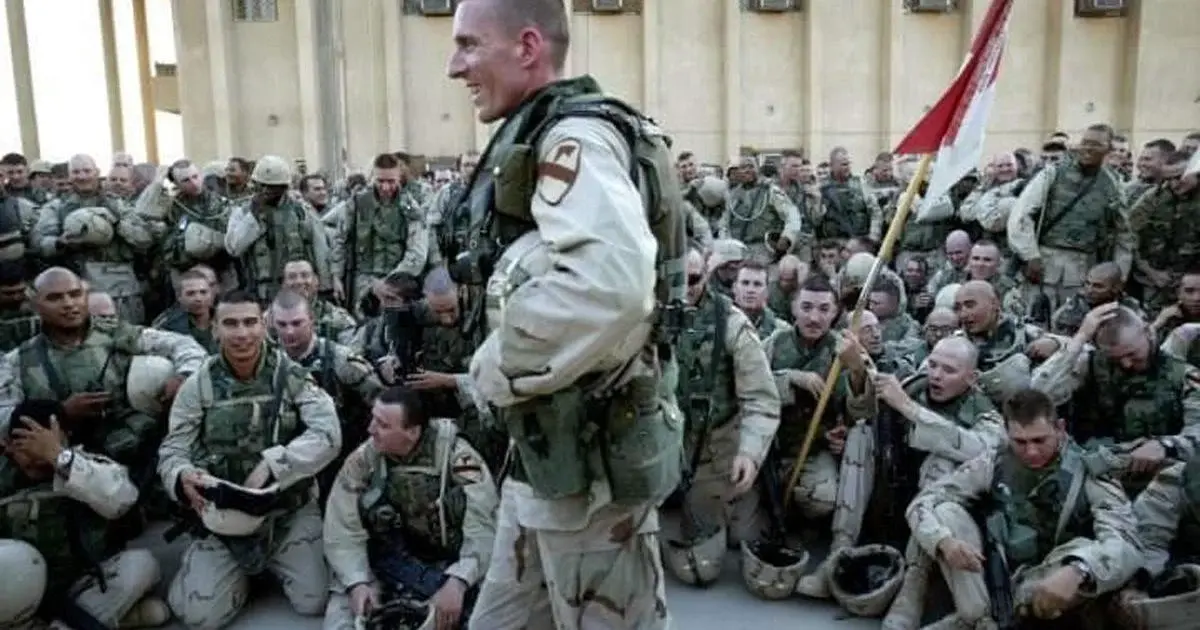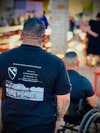1st Cav veterans remember ‘Black Sunday’ battle 20 years later
Veterans gathered at Fort Cavazos on the 20th anniversary of a Palm Sunday battle that killed eight and altered the course of the Iraq war.

Thursday marked the 20th anniversary of the battle known as “Black Sunday,” a battle in Sadr City, Iraq in which a platoon from the ‘Lancer’ battalion of the 1st Cavalry Division was caught in a patrol-turned-urban-combat ambush under heavy fire from machine guns, rifles and rocket propelled grenades of Shiite militiamen.
The battle marked a turning point of violence in Sadr City, and came on the unit’s 1st full day in the city. During the battle, eight soldiers died and over 50 were wounded as other Lancers fought their way through crowded streets to save them.
More than 200 veterans and family members from the 2nd Battalion 5th Cavalry Regiment — the “2-5,” as they call themselves — who served during the battle came together at Fort Cavazos, Texas on Thursday.
“It was a huge change in the U.S. Army’s approach to the cities that we were in. Sadr City was one of three or four other locations around Baghdad at that time that basically the insurgency started to fight back pretty aggressively,” said Clay Spicer, a Lieutenant at the time who was part of the first convoy sent out to rescue the trapped soldiers. “Black Sunday definitely represents a committed ground force approach to defending our soldiers that were over there.”
The 1st Brigade’s area of operation included Sadr City, home to nearly 2.5 million people, where they spent their deployment assisting in million-dollar projects to improve essential services like sewer, electric and water systems and remove IED risks to civilians.

The former commander of the 1st Brigade Combat Team, Gen Robert Abrams, testified to the House Armed Services Committee in 2005 about the unit’s mission and the fight that 2-5 soldiers found themselves in.
“The Iraqi men and women in my area were incredibly thankful to be rid of Saddam Hussein and extremely thankful for what we were doing for their people. We may not have always agreed on how we were doing certain things, but our presence was certainly always wanted,” Abrams told lawmakers.
Abrams said that unlike other parts of Baghdad, the “primary enemy” for the 12-month tour were militia loyalists to Muqtada al-Sadr. U.S. troops engaged in two separate periods of full-scale, high-intensity combat operations over the span of two months.
“We were handing out chicken one day and the next day we were fighting,” said Reggie Butler, who was a sergeant first class at the time.
Over the course of the one-year deployment, their unit lost 15 soldiers and more than 100 wounded – at least half were sent back to the U.S. for their injuries, according to Spicer.
“We stayed in combat operations for probably 10 of those 12 months,” Spicer said.

April 4, 2004
The soldiers of 2-5 deployed to Iraq in March 2004 and April 4, Palm Sunday, was their first official day on duty after transitioning the area’s responsibility from a previous regiment. Because of the transition, the unit’s radios were not yet set up, Butler said, adding, “that right there played a key factor in the failure of the mission and the communications.”
The city had been relatively calm and soldiers were expecting a peace-keeping mission, according to Butler.
“There hadn’t been a shot fired in Sadr City in six months,” Spicer said. “We weren’t expecting a battle of that level at that point and we stayed in sustained combat operations for the next 90 days.”
Earlier that day, unknown to American forces, al-Sadr had directed his militia to attack all coalition forces.
Subscribe to Task & Purpose today. Get the latest military news and culture in your inbox daily.
It was during a routine escort of local sewage trucks when a platoon of soldiers suddenly came under attack by what Abrams estimated to be about 1,000 militia fighters. Spicer said it was closer to 1,500 to 2,000. Within seconds, two of the Americans’ vehicles were immobilized, the platoon leader’s gunner was killed and two others seriously wounded.
The remaining platoon moved into an alley and then took over an Iraqi residence where they found a mother with three young children, Abrams described.
Staff Sgt. Eric Bourquin went to the roof with another soldier to set up an automatic weapons position to provide cover. By now, seven soldiers were wounded. Bourquin spent hours trading places between the roof and downstairs to help the platoon’s medic attend to wounded soldiers.
Sfc. Jerry Swope stayed in an up-armored Humvee in the alley. The truck had the only working radio to call for additional support. Over the course of the battle, Swope directed close air support as the Humvee sustained at least 15 RPG direct hits.
Bourquin, thinking on his feet, lit his shirt on fire, to signal the platoon’s location to the helicopters circling overhead. Once the pilots spotted the platoon, they provided protective fire as other ground teams rushed to help.
Over the next four hours, the pinned down soldiers fought off the militia while the skies grew darker. Other units, including a team led by Butler, fought their way to the trapped platoon. Butler said he remembers hearing more and more soldiers call for help as they were shot over their small, civilian-style radios, the only ones that were working.
When Butler got back to the base, “it was just so many bodies,” he said. “Out of 37 soldiers that I took over there that night, I only had 19 standing.”
“I do remember telling people you can’t go out there and not be prepared because this is real, you can’t go out with thin-skin vehicles and we don’t have much armor,” he said. “We thought it was gonna be a peacekeeping mission not an actual combat fighting engagement type mission.”
Killed in the battle were Spc. Robert Arsiaga, Spc. Ahmed Cason, Spc. Israel Garza, Spc. Stephen Hiller, Cpl. Forest Jostes, Sgt. Michael Mitchell and Spc. Casey Sheehan.
While soldiers in the 1st Brigade Combat Team were wounded at twice the rate of other units during the 2004 deployment, more of its soldiers re-enlisted than any other brigade-sized unit in the Army, Abrams said.
Somber Anniversary
Twenty years on, the 2-5 soldiers looked back on that day as the one that changed their lives and Army careers forever. Butler said it changed the way he trained, realizing his job wasn’t just about him, but his fellow soldiers.
The fatal event was chronicled in a book by journalist, Martha Raddatz, which was turned into a National Geographic series titled, “The Long Road Home” in 2017. The 12-acre Sadr City set for the show was constructed on Fort Hood’s “Elijah” training area as a mockup of a Middle Eastern town used for urban warfare training. It was also the same site where members of 2-5 trained prior to their Iraq deployment.
“The date of 4-4-4, that’s now 20 years later. It never goes out of your mind,” Spicer said. “We think about this every single day of our lives. We just come together as best we can once a year and honor the guys that we lost.”
The latest on Task & Purpose
- Air Force special operators must take class before getting shaving waivers
- Camp Pendleton Marines encouraged to fix their own barracks rooms
- 101st Airborne soldiers are first to receive new Next Gen Squad Weapon
- Air Force fires commander of Holloman maintenance group
- Army investigating Nazi imagery on Special Forces patch posted online
